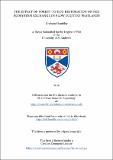Files in this item
The effect of forest-to-bog restoration on net ecosystem exchange in Flow Country peatlands
Item metadata
| dc.contributor.advisor | Wilson, Rob | |
| dc.contributor.advisor | Rinterknecht, Vincent | |
| dc.contributor.author | Hambley, Graham | |
| dc.coverage.spatial | xi, 262 p. | en_US |
| dc.date.accessioned | 2019-09-25T15:31:20Z | |
| dc.date.available | 2019-09-25T15:31:20Z | |
| dc.date.issued | 2016-11-30 | |
| dc.identifier.uri | https://hdl.handle.net/10023/18563 | |
| dc.description.abstract | Northern peatlands play a critical role in the regulation of atmospheric carbon (C) and are estimated to store approximately 550 Gt C, which is around a quarter of the world soil C pool. Saturated conditions means aboveground net primary productivity is low, but also results in low decomposition and subsequently low respiratory losses. The Flow Country of Caithness and Sutherland, Northern Scotland is the one of the largest areas of contiguous blanket bog in Europe encompassing an area in excess of 4000 km². However, these peatlands were badly degraded in the 1970s and 1980s by large-scale forestry plantations with around 17% of the Flow Country drained and planted with Sitka spruce and Lodgepole pine altering net ecosystem C functioning. Restoration efforts have been on going since the 1990s to restore these sites to blanket bog and return them to net C sinks. Using eddy covariance techniques this research sought to understand C dynamics over two sites restored at different times, assess their C sink/source status and the key environmental factors driving changes in C dynamics. Results showed the youngest restoration site (Lonielist; restored in 2003/04) to be a net source of C to the atmosphere of 80 g C m⁻² yr⁻¹, while the older restoration site (Talaheel; restored in 1997/98) was a net C sink of -71 g C m⁻² yr⁻¹. Partitioning of the net exchange into its constituent parts of respiration (R[sub](eco)) and photosynthesis (GPP) found significant differences in R[sub](eco) between the two sites, whilst no significant differences were observed in GPP. Soil temperature and soil moisture were found to be the greatest controls on R[sub](eco), with higher R[sub](eco) associated with drier, warmer conditions. Incident solar radiation controlled GPP, however dry periods coupled with high vapour pressure deficit resulted in a limitation of photosynthesis. These results highlight that peatland restoration is successful at returning sites to net C sinks over multi-decadal timescales. | en |
| dc.language.iso | en | en_US |
| dc.publisher | University of St Andrews | en |
| dc.rights | Attribution-NonCommercial-NoDerivatives 4.0 International | * |
| dc.rights.uri | http://creativecommons.org/licenses/by-nc-nd/4.0/ | * |
| dc.subject | Peatlands | en |
| dc.subject | Peatland restoration | en |
| dc.subject | Carbon | en |
| dc.subject | Flow Country | en |
| dc.subject | Net ecosystem exchange | en |
| dc.subject | Respiration | en |
| dc.subject | Photosynthesis | en |
| dc.subject | Eddy covariance | en |
| dc.subject | Northern Hemisphere | en |
| dc.subject | Soil carbon | en |
| dc.subject.lcc | QH77.S3H2 | |
| dc.subject.lcsh | Peatland restoration--Scotland--Flow Country | en |
| dc.subject.lcsh | Peatland ecology--Scotland--Flow Country | en |
| dc.subject.lcsh | Scotland--Flow Country | en |
| dc.title | The effect of forest-to-bog restoration on net ecosystem exchange in Flow Country peatlands | en_US |
| dc.type | Thesis | en_US |
| dc.contributor.sponsor | Royal Society for the Protection of Birds | en_US |
| dc.contributor.sponsor | University of St Andrews | en_US |
| dc.type.qualificationlevel | Doctoral | en_US |
| dc.type.qualificationname | PhD Doctor of Philosophy | en_US |
| dc.publisher.institution | The University of St Andrews | en_US |
The following licence files are associated with this item:
This item appears in the following Collection(s)
Except where otherwise noted within the work, this item's licence for re-use is described as Attribution-NonCommercial-NoDerivatives 4.0 International
Items in the St Andrews Research Repository are protected by copyright, with all rights reserved, unless otherwise indicated.


